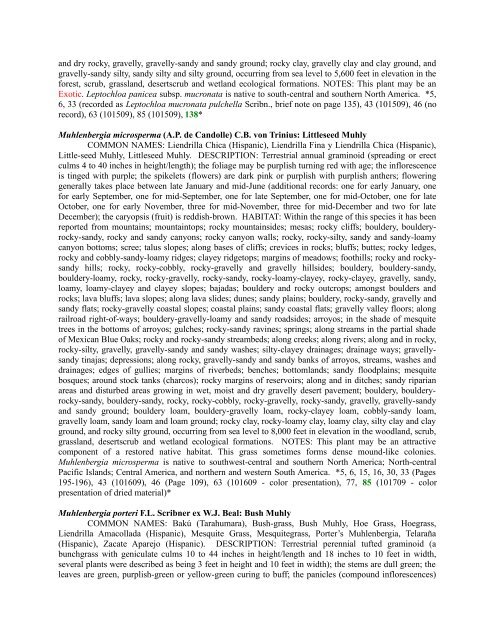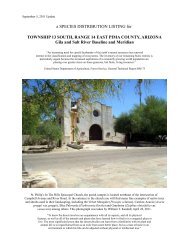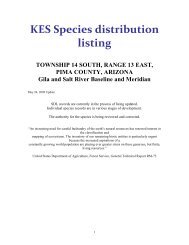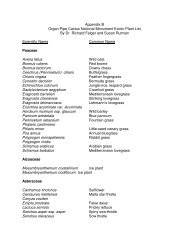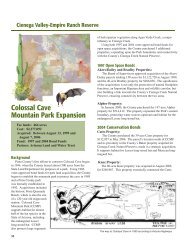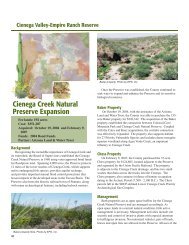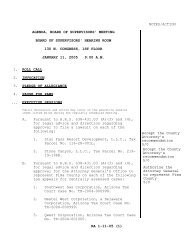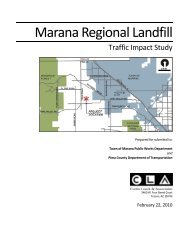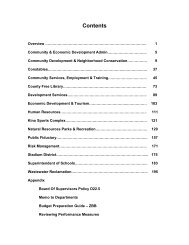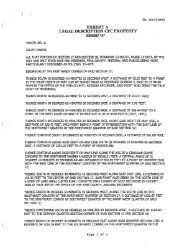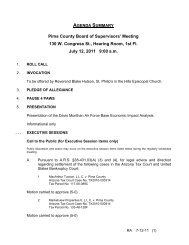Le Jardin de Mère Nature dans une Petite Planète - Pima County
Le Jardin de Mère Nature dans une Petite Planète - Pima County
Le Jardin de Mère Nature dans une Petite Planète - Pima County
You also want an ePaper? Increase the reach of your titles
YUMPU automatically turns print PDFs into web optimized ePapers that Google loves.
and dry rocky, gravelly, gravelly-sandy and sandy ground; rocky clay, gravelly clay and clay ground, and<br />
gravelly-sandy silty, sandy silty and silty ground, occurring from sea level to 5,600 feet in elevation in the<br />
forest, scrub, grassland, <strong>de</strong>sertscrub and wetland ecological formations. NOTES: This plant may be an<br />
Exotic. <strong>Le</strong>ptochloa panicea subsp. mucronata is native to south-central and southern North America. *5,<br />
6, 33 (recor<strong>de</strong>d as <strong>Le</strong>ptochloa mucronata pulchella Scribn., brief note on page 135), 43 (101509), 46 (no<br />
record), 63 (101509), 85 (101509), 138*<br />
Muhlenbergia microsperma (A.P. <strong>de</strong> Candolle) C.B. von Trinius: Littleseed Muhly<br />
COMMON NAMES: Liendrilla Chica (Hispanic), Liendrilla Fina y Liendrilla Chica (Hispanic),<br />
Little-seed Muhly, Littleseed Muhly. DESCRIPTION: Terrestrial annual graminoid (spreading or erect<br />
culms 4 to 40 inches in height/length); the foliage may be purplish turning red with age; the inflorescence<br />
is tinged with purple; the spikelets (flowers) are dark pink or purplish with purplish anthers; flowering<br />
generally takes place between late January and mid-J<strong>une</strong> (additional records: one for early January, one<br />
for early September, one for mid-September, one for late September, one for mid-October, one for late<br />
October, one for early November, three for mid-November, three for mid-December and two for late<br />
December); the caryopsis (fruit) is reddish-brown. HABITAT: Within the range of this species it has been<br />
reported from mountains; mountaintops; rocky mountainsi<strong>de</strong>s; mesas; rocky cliffs; boul<strong>de</strong>ry, boul<strong>de</strong>ryrocky-sandy,<br />
rocky and sandy canyons; rocky canyon walls; rocky, rocky-silty, sandy and sandy-loamy<br />
canyon bottoms; scree; talus slopes; along bases of cliffs; crevices in rocks; bluffs; buttes; rocky ledges,<br />
rocky and cobbly-sandy-loamy ridges; clayey ridgetops; margins of meadows; foothills; rocky and rockysandy<br />
hills; rocky, rocky-cobbly, rocky-gravelly and gravelly hillsi<strong>de</strong>s; boul<strong>de</strong>ry, boul<strong>de</strong>ry-sandy,<br />
boul<strong>de</strong>ry-loamy, rocky, rocky-gravelly, rocky-sandy, rocky-loamy-clayey, rocky-clayey, gravelly, sandy,<br />
loamy, loamy-clayey and clayey slopes; bajadas; boul<strong>de</strong>ry and rocky outcrops; amongst boul<strong>de</strong>rs and<br />
rocks; lava bluffs; lava slopes; along lava sli<strong>de</strong>s; d<strong>une</strong>s; sandy plains; boul<strong>de</strong>ry, rocky-sandy, gravelly and<br />
sandy flats; rocky-gravelly coastal slopes; coastal plains; sandy coastal flats; gravelly valley floors; along<br />
railroad right-of-ways; boul<strong>de</strong>ry-gravelly-loamy and sandy roadsi<strong>de</strong>s; arroyos; in the sha<strong>de</strong> of mesquite<br />
trees in the bottoms of arroyos; gulches; rocky-sandy ravines; springs; along streams in the partial sha<strong>de</strong><br />
of Mexican Blue Oaks; rocky and rocky-sandy streambeds; along creeks; along rivers; along and in rocky,<br />
rocky-silty, gravelly, gravelly-sandy and sandy washes; silty-clayey drainages; drainage ways; gravellysandy<br />
tinajas; <strong>de</strong>pressions; along rocky, gravelly-sandy and sandy banks of arroyos, streams, washes and<br />
drainages; edges of gullies; margins of riverbeds; benches; bottomlands; sandy floodplains; mesquite<br />
bosques; around stock tanks (charcos); rocky margins of reservoirs; along and in ditches; sandy riparian<br />
areas and disturbed areas growing in wet, moist and dry gravelly <strong>de</strong>sert pavement; boul<strong>de</strong>ry, boul<strong>de</strong>ryrocky-sandy,<br />
boul<strong>de</strong>ry-sandy, rocky, rocky-cobbly, rocky-gravelly, rocky-sandy, gravelly, gravelly-sandy<br />
and sandy ground; boul<strong>de</strong>ry loam, boul<strong>de</strong>ry-gravelly loam, rocky-clayey loam, cobbly-sandy loam,<br />
gravelly loam, sandy loam and loam ground; rocky clay, rocky-loamy clay, loamy clay, silty clay and clay<br />
ground, and rocky silty ground, occurring from sea level to 8,000 feet in elevation in the woodland, scrub,<br />
grassland, <strong>de</strong>sertscrub and wetland ecological formations. NOTES: This plant may be an attractive<br />
component of a restored native habitat. This grass sometimes forms <strong>de</strong>nse mound-like colonies.<br />
Muhlenbergia microsperma is native to southwest-central and southern North America; North-central<br />
Pacific Islands; Central America, and northern and western South America. *5, 6, 15, 16, 30, 33 (Pages<br />
195-196), 43 (101609), 46 (Page 109), 63 (101609 - color presentation), 77, 85 (101709 - color<br />
presentation of dried material)*<br />
Muhlenbergia porteri F.L. Scribner ex W.J. Beal: Bush Muhly<br />
COMMON NAMES: Bakú (Tarahumara), Bush-grass, Bush Muhly, Hoe Grass, Hoegrass,<br />
Liendrilla Amacollada (Hispanic), Mesquite Grass, Mesquitegrass, Porter’s Muhlenbergia, Telaraña<br />
(Hispanic), Zacate Aparejo (Hispanic). DESCRIPTION: Terrestrial perennial tufted graminoid (a<br />
bunchgrass with geniculate culms 10 to 44 inches in height/length and 18 inches to 10 feet in width,<br />
several plants were <strong>de</strong>scribed as being 3 feet in height and 10 feet in width); the stems are dull green; the<br />
leaves are green, purplish-green or yellow-green curing to buff; the panicles (compound inflorescences)


